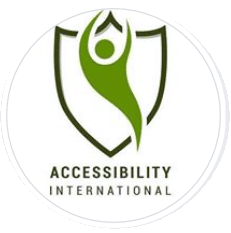In our upcoming seminar titled “Inclusive Design: The Big Picture”, part of our 2020 series of seminars, Eric Eggert, Knowbility’s Tech Team Lead and Web Accessibility Expert, will be providing his expertise, demystifying inclusive design, and teaching attendees how to make inclusive design an ongoing concern and integrate it into their daily routines.
If you’re unfamiliar with inclusive design, it describes a process of welcoming all people from different and intersectional backgrounds to use your products and services in ways that are meaningful to them, while including diverse individuals throughout the research and design process. There is no single approach, nor a one size fits all technique, but rather a series of strategies and options that can be implemented, monitored, and optimized over time.

In preparation for the webinar, we interviewed Eric about inclusive design and the importance of designing for all. In addition, we discuss how teams can implement inclusive design by integrating it into their team’s best practices with the help of an organization like Knowbility.
Knowbility: Eric, you’re obviously passionate about inclusive design, what got you started and how has it kept you going up until today?
Eric: It’s a combination of factors, really. I was raised with a strong sense of equity for everyone and I saw how society can benefit some groups and let others down. I think my first eureka moment growing up was when a friend of mine, who was using a wheelchair, had to go to a “special” school here in Germany because other schools were inaccessible. He had exactly one option to participate in the education system, while I always had multiple options. The problem was even worse as all disabled children, I think except blind individuals, went to the same school, creating one learning environment for people with cognitive disabilities and motor impairments. Specific assistance for individuals would be a much better model.
As for what keeps me going: My love for the internet as a medium, really. It is something that we as a society are so accustomed now, everyone uses it. And I just want to make sure that everyone can still use it forever, regardless of disability or age. And deep down, I, selfishly, don’t want to lose access. So, I work to keep it.
Knowbility: What would you say are some of the biggest benefits of implementing an all-encompassing inclusive design philosophy?
Eric: I think the biggest benefit is to see different perspectives: understand other viewpoints, different cultural backgrounds, and socio-economic challenges, to just name a few. It broadens the understanding of the motivation of other people, a skill that becomes more useful every day. And because Inclusive Design thinks about “extreme use cases” first, it creates the unique opportunity of not having one product for all, but products that can address unique problems at once.
Register Now for “Inclusive Design: The Big Picture” →
Knowbility: How can someone unfamiliar with inclusive design learn more and stay up to date with changing trends and techniques?
Eric: Because Inclusive Design is more a philosophy than a technique, I don’t think there is a lot to stay up to date on. In my seminar I will show how you can use design principles to make sure you keep hitting the mark. The most important aspect is that you keep checking your work and have a plan.
Knowbility: What are some of the biggest challenges an organization might face when implementing Inclusive Design?
Eric: You cannot flip the switch and be “inclusive” from one day to another. It requires leadership and a clear plan that incentivizes promoting and trusting diverse employees. A big error that many companies make is tokenization: The one Black person in customer service, the one woman developer, the one trans person in bookkeeping. Hiring people with different backgrounds is useful to make inclusion visible; however, it is not a checklist. You need to think inclusively every step of the process. And that means making mistakes and re-evaluate and changing the processes.
Knowbility: What do you see in the future for inclusive design?
Eric: I don’t know how to answer that, really. I hope it gets to a point where we can drop Inclusive Design as a concept because all design is inclusive. Until then, I hope that society and companies move into a more inclusive direction. For some incremental changes will get them there, others need more radical approaches.
Knowbility: Thank you very much for answering these questions and shining a light on inclusive design!
To learn even more about inclusive design, be sure to sign up for “Inclusive Design: The Big Picture”, taking place Thursday, September 3, 2020, from 9:30 AM to 1:30 PM (CT). Register for the seminar on EventBrite:
Register Now for “Inclusive Design: The Big Picture” →
You can also learn more about Eric Eggert and his work with Knowbility here.
Be sure to like and follow us on your favorite social media platforms, and to sign up for our newsletter so that you can be the first to know about upcoming seminars, events, and news.




